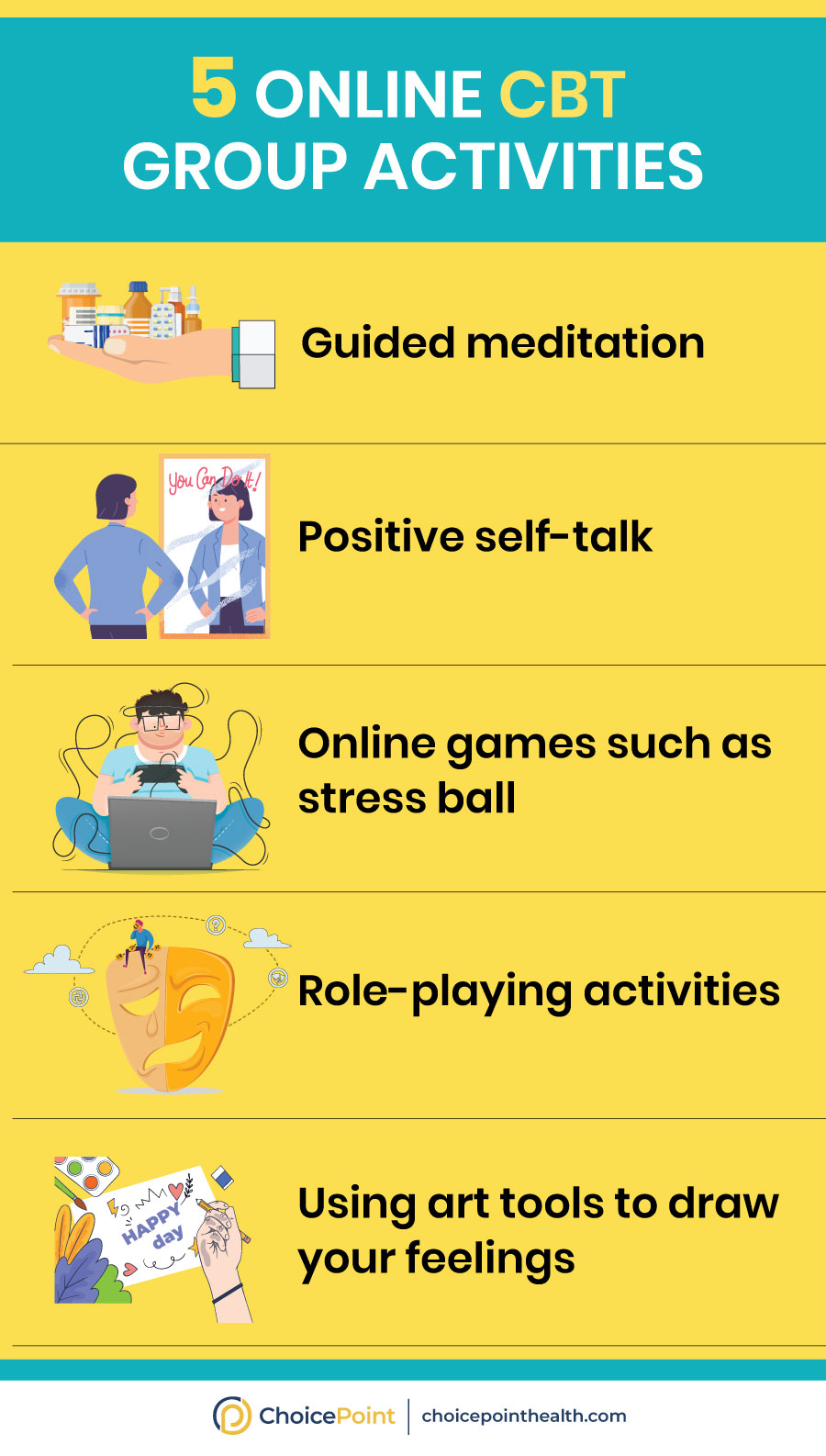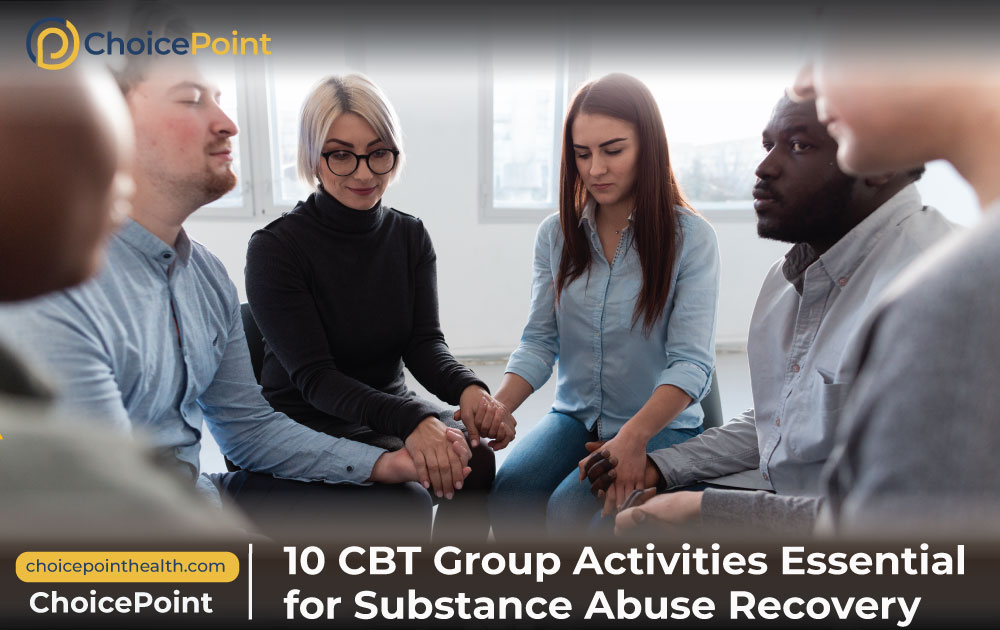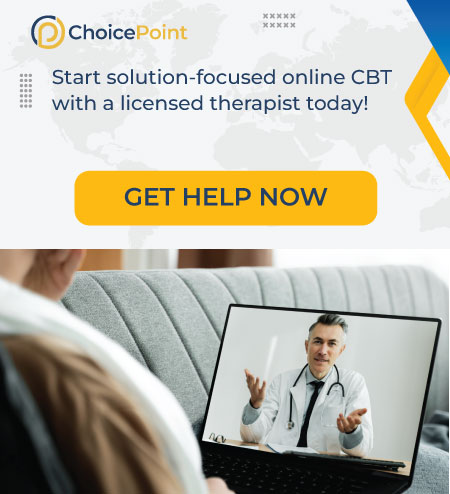Cognitive behavioral group therapy aims to create a collaborative environment that fosters emotional and mental well-being. Our list of top 10 CBT group activities is designed to help you manage stress, build a positive perspective, overcome triggers, maintain sobriety, and help you overcome addiction treatment challenges in an uplifting environment.
Virtual cognitive-behavioral therapy is as effective as an in-person session. To connect with a licensed therapist at ChoicePoint, please call us at 844.445.2563.
Table of Contents
CBT For Substance Abuse Recovery: Does It Work?
Addiction treatment presents unique challenges. Withdrawal from benzodiazepines, opioids, illegal drugs, alcohol, and other prescription drugs is often associated with mental health issues such as anxiety and depression. This makes therapeutic interventions essential for complete recovery.
Cognitive-behavioral therapy is a structured and goal-oriented form of behavioral therapy. Take a look at scientific data to evaluate the effectiveness of CBT:
- Research establishes that behavioral therapy is highly effective for treating substance use disorder, especially cannabis and nicotine addiction.
- 60% of patients suffering from cocaine addiction who availed of CBT along with treatment were free of addiction after 52 weeks duration.
- A meta-analysis of 26 researchers concluded CBT in relapse prevention is highly effective for alcohol use disorder.

Did you know? 1 in 5 American women suffer from mental health problems. Call today at 844.445.2563 to connect with a licensed therapist.

Did you know? 1 in 5 American women suffer from mental health problems. Call today at 844.445.2563 to connect with a licensed therapist.
10 Best CBT Group Activities Essential For SUD Treatment
Addiction treatment is challenging but a very transformative experience. Whether you are a recovering addict or a therapist looking to step up the group therapy experience, we have got you covered with well-researched, goal-oriented, and engaging activities for group therapy.
CBT Group Activities For Adults
Let’s dive into the list of CBT group activities for adults recovering from substance use disorder and mental health issues.
1. Thought Replacement Activity
Thought replacement or cognitive restructuring is one of the fundamentals of CBT. People suffering from SUD often have negative thinking patterns. You can encourage the clients to create a worksheet with negative thoughts to change the negative perspective.
In the CBT worksheet, like below, the clients can record their negative thoughts according to the situation. Pass the worksheet around the group and allow other clients to offer a positive perspective and discuss it among the group members. For example:
| Situation | Automatic Negative Thought | Positive Perspective |
| Experienced a relapse. | I am not good enough. Recovery is not worth it; maybe I should just quit. | Relapse is common. I should identify what led to the relapse and talk about it with my doctor. |
2. Lock and Key Activity To Combat Loneliness
People opting for group therapy and support groups are often looking for peers to offer guidance and support in their recovery journey. Lock and key activities can be fun to break the ice and allow peers to connect and share their experiences.
Randomly assign locks to half of the group and keys to the other half. Allow people to mingle and match their keys to the locks. Those whose keys fit into the lock can sit together and discuss their challenges and offer insights into the recovery journey.
3. Problem-Solving Activity To Manage Triggers
Helping clients to identify and manage the triggers that might cause a relapse is essential in CBT for addiction treatment. You can follow these steps:
- Hand out cards to all the group members
- Have them write the triggers
- Pass the papers around the group
- Ask group members to checkmark the card if they experience the same trigger
- Talk about the triggers with most check marks to reinforce that they are not alone and share these situations with other team members.
- Circulate a worksheet like the one in the example below to help your clients manage the triggers in real-life situations.
| Trigger | Consequence of the trigger | Your reaction to the trigger | Reminder to yourself about the necessary steps to take to combat the trigger |
4. Learning To Say No To Substance Use
Peer pressure is perhaps one of the greatest obstacles to recovery. Some people find it hard to say no to substance use in social gatherings or parties. Through this activity, you can encourage your participants to say no to drug use clearly.
- Allow your clients to brainstorm the situations where they could not refuse when offered drugs or alcohol.
- Ask them to list the short-term and long-term consequences of not refusing substance use.
- Start a role play, creating situations where clients can formulate a response if offered to use drugs. They can practice saying no when they are offered any substance.
You can also encourage clients to replace addiction with healthy hobbies and transformative activities to uplift the recovery experience.
5. Cognitive Restructuring Activity
Cognitive restructuring or reframing quickly counteracts your negative thoughts by noticing positive things. For example:
- Ask the participants about the first thing they notice in the room.
- If some have negative thoughts, like the room is too small, you can push them to notice positive things, like the couch is comfortable quickly and the wall art looks great.
- Allow participants to set reminders on the phone or keep a gratitude journal to notice and appreciate the positive things.

CBT Interventions Group Activities
CBT Group Activities For Youth
Although the exercises mentioned earlier can be conducted for adolescents, here is a list of fun and engaging CBT group activities for youth. These are designed to help teens and young ones feel supported in their recovery journey.
6. Positive Affirmations And Compassion Box
CBT group activities for youth should be specific to your target audience. Substance abuse in adolescents and teens often results in low self-esteem in vulnerable teens. Positive affirmations are a great way to boost self-worth. Some examples of positive affirmations include:
- I am stronger than my worst fears.
- I am worth the recovery.
- I am changing how I feel.
You can also keep a compassion box in which group members can write positive notes for other members. Members can read them at the end of the session. This will help them feel validated and appreciated.
7. Mood Tracker
Daily mood charts or mood trackers are a great way to help clients understand the link between their environment, situation, and feelings. Clients can record the emotions they experience throughout the day. Therapists can then help members understand the relationship between situations and emotions and how clients can better cope with those emotions in the future.
8. Cognitive Skill Practicing Through Role Play
Role-playing offers a safe space for group therapy participants to confront their fears and negative thoughts. Acting in different scenarios can help patients to develop better coping strategies for difficult situations. For example, a teen is facing a negative stigma for going through addiction treatment. The therapist can enact the scene with group members and help the teen practice taking a stand for himself in a real-life situation.
9. Behavioral Activation Through Gratitude Journaling
Behavioral activation involves identifying and engaging in positive behavior. You can encourage members to keep a gratitude journal and write everything they are grateful for. This will be beneficial to counteract any depressive thoughts.
10. Practicing Mindfulness Through Meditation
Mindfulness is the state of being alert to your surroundings. Imagine taking a walk, preoccupied with all the ongoing stuff. Now, imagine taking a mindful walk with your support group peers. You are aware of the gentle sunshine touching your face. You can hear the birds chirping. See the butterflies flying. Enjoy the children playing. Your heart will automatically be filled with peace and gratitude. This peace will help you stay motivated towards your recovery journey.

Alarming Fact: In 2021, more than 1 in 5 students seriously considered attempting suicide, and 1 in 10 attempted suicide.

Alarming Fact: In 2021, more than 1 in 5 students seriously considered attempting suicide, and 1 in 10 attempted suicide.
CBT Group Therapy Near Me
Now that you know CBT is a great way to heal your mind and body; you might be looking for a therapy program near you. With telehealth services, sessions with a licensed and experienced therapist are just a click away!
We offer not only CBT but also other in-person and online behavioral therapies that are best suited to your needs. These include:
Along with group CBT activities, we offer holistic addiction treatment programs for wholesome recovery. Some of our specialized programs include:
- Student addiction treatment
- LGBTQ addiction treatment
- Addiction treatment for pregnant women
- Criminal justice addiction treatment
- Medication-assisted treatment
Do not wait any longer. Book your appointment today by calling us at 844.445.2563.
Frequently Asked Questions Related To CBT Group Activities
Our clients often ask us these questions related to CBT group activities.
How is CBT used in Group Therapy?
In group CBT therapy, patients with similar conditions are placed in one group. A therapist works with the clients to identify how their negative thoughts affect emotions and behaviors. A therapist aims to reshape your thoughts towards a more positive perspective for better behavioral outcomes.
What is a CBT Activity?
CBT activities are solution-focused exercises and techniques that aim to improve mental health and substance abuse treatment outcomes in a fun and engaging way. These are targeted to help you adopt a more positive perspective.
What is a CBT Skills Group?
CBT skills group is a course that teaches mindfulness, your emotions, and the interconnection of thoughts, feelings, and behaviors.
What Are the Techniques of Group Therapy?
Group therapy techniques include:
- Solution-oriented group discussions
- Mindfulness-based activities
- Cognitive-behavioral role playing
- Emotion processing activities
Does Insurance Cover Online CBT?
Yes, online CBT is covered by insurance. However, the extent of coverage differs from company to company. Please verify your insurance to avoid any inconvenience.
Medical Disclaimer:
ChoicePoint aims to improve the quality of life for people struggling with substance use disorder and mental health issues. Our team of licensed medical professionals research, edit and review the content before publishing. However, this information is not intended to be a substitute for professional medical advice, diagnosis, or treatment. For medical advice please consult your physicians or ChoicePoint's qualified staff.










Review 10 CBT Group Activities Essential for Substance Abuse Recovery.